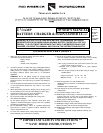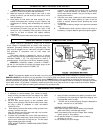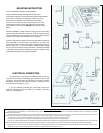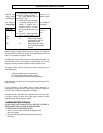
Model SE 112S is intended for use with 12 volt battery systems only. The
charger contains an electronic control circuit which safeguards against
overcharging the battery.
After reading and following the directions
"Charging battery in vehicle" or
"Charging battery out of vehicle, " you
may observe the following conditions:
Light color on/off Condition
Green off Check wall receptacle for 120
volts or check lead connec
tions, may be reversed.
Green on
AC
Power is present.
Red on Battery charger voltage is
approximately 14 volts and
charging has stopped.
Red off Battery voltage has dropped
one volt and the charging has
resumed.
The on/off cycle of the red light will continue, the red light will stay on for longer
periods of time as the battery becomes more fully charged. Your charger has
been designed NOT to spark if the ring lugs on the leads accidentally touch one
another, or if the leads are connected in reverse.
The battery must measure at least 2 volts to start the charging of the battery. The
green light will be on even if the charging is not taking place. You can verify
charging by measuring the battery voltage and noting an increase in volts.
This charger is ideally suited for maintaining the battery charge level for the
following applications.
1. Storage of a battery during non-seasonal use.
2. For vehicles seldom used or placed in storage.
3. For improved battery performance during cold weather.
Smaller batteries such as those used on motorcycles and garden tractors can be
charged overnight.
For large automotive or marine battery which are deeply discharged, it is
recommended to recharge first with a larger charger (such as a 10 amp) then
use the SE 112S to maintain the charge level of the battery.
If the battery is used in automobile or other application which has its own means
of charging a battery, the above time maybe greatly reduced by partially
charging the battery before applying the charger.
CHARGING BATTERY IN VEHICLE
FOLLOW THESE STEPS WHEN BATTERY IS INSTALLED IN VEHICLE A
SPARK NEAR BATTERY MAY CAUSE BATTERY EXPLOSION.
TO REDUCE RISK OF SPARK NEAR BATTERY;
1. Position
AC
and DC cords to reduce risk of damage by hood,
door or moving parts.
2. Stay clear of fan blades, belts, pulleys and other parts that can
cause injury.
OPERATING INSTRUCTIONS
3. Check polarity of battery posts.
POSITIVE (+) battery post usually
has a larger diameter than the
NEGATIVE (-) post.
4. Determine which post of battery
is grounded (connected to the
chassis). If negative post is
grounded to chassis, as in most
vehicles, see item 5. If positive
post is grounded to chassis, see
item 6.
5. For common negative grounded
vehicle connect positive (red)






